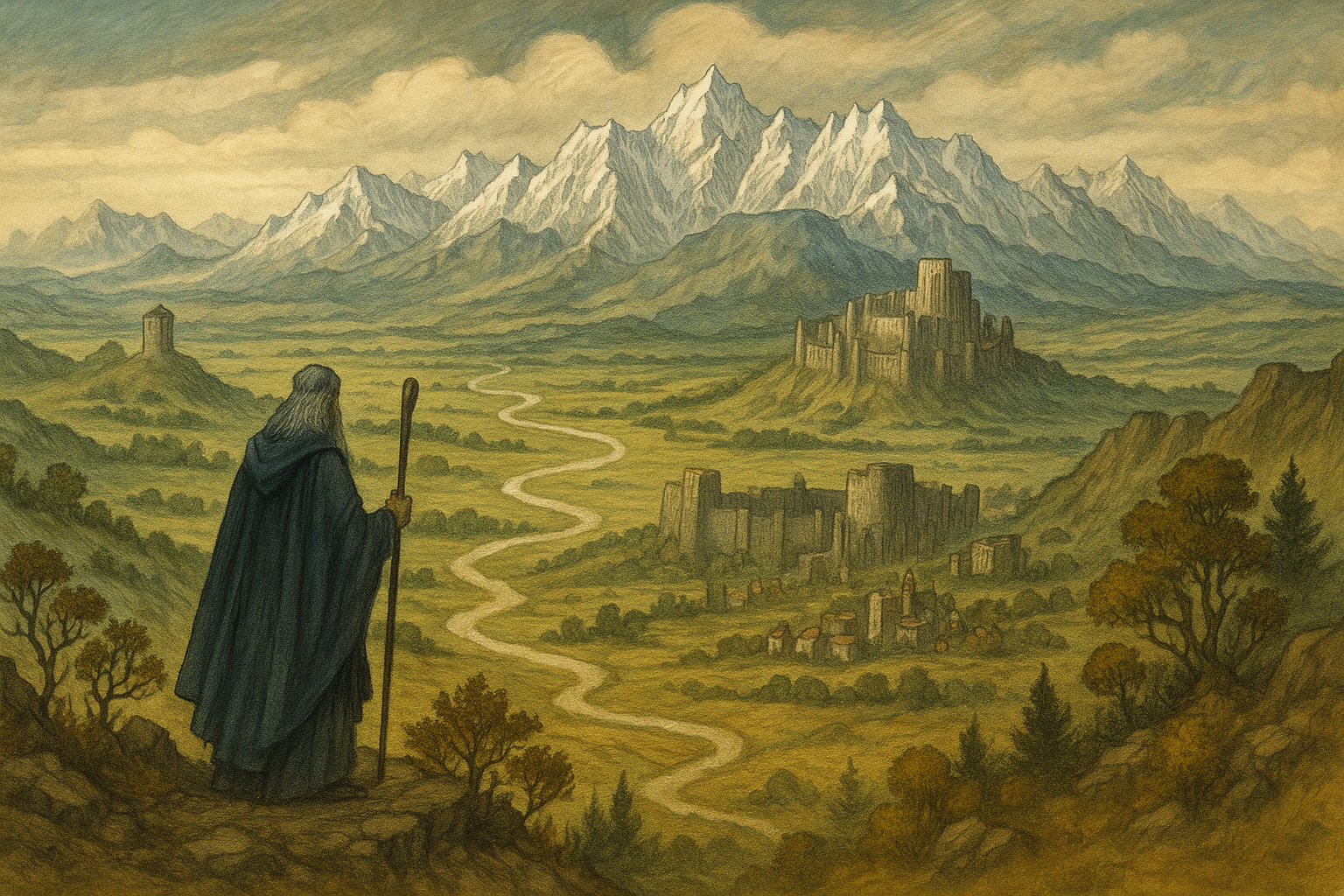History of Middle-Earth, Part 3 – The Road to Númenor and the Shaping of History

From Myth to History
The first five volumes of The History of Middle-Earth show Tolkien as a mythmaker—dreaming in grand cosmological themes, experimenting with epic poetry, and sketching tragic tales of Elves and heroes. But as the 1930s unfolded, his writing began to shift. The scattered myths started to align into a coherent narrative. Maps, genealogies, and chronicles gave Middle-Earth a sense of historical depth.
This transitional period is captured in two crucial volumes: The Shaping of Middle-Earth and The Lost Road and Other Writings. Here we see Tolkien wrestling not only with stories but with the very structure of his mythology.

Volume 4 Revisited: The Shaping of Middle-Earth (1986)
We first encountered The Shaping of Middle-Earth in Part 2, but it deserves another look. This volume is a watershed moment because it shows Tolkien consolidating his earlier stories into a recognizable form.
- The Quenta Noldorinwa – an early prose version of the Silmarillion narrative, telling of the Elves’ rebellion and exile.
- The Ambarkanta – an essay describing the cosmology and physical layout of Tolkien’s world, complete with maps.
- The Earliest Annals – chronological lists of events in Valinor and Beleriand.
What makes this volume important is its attempt at systematization. No longer were these tales isolated myths; they were now part of a unified chronology. In this way, Tolkien was shaping not just a mythology but a history—layered, dated, and interconnected.

Volume 5 Revisited: The Lost Road and Other Writings (1987)
If The Shaping of Middle-Earth was about structure, The Lost Road was about vision. This volume introduces one of Tolkien’s most enduring themes: the rise and fall of Númenor.
Númenor as Atlantis
Númenor is Tolkien’s Atlantis—a great island kingdom gifted to Men as a reward for their faithfulness but destroyed in a cataclysm when they turned to pride and rebellion. The Númenóreans’ yearning for immortality, their eventual corruption, and their downfall would later echo through The Lord of the Rings, particularly in Aragorn’s lineage and Gondor’s fading glory.
The Time-Travel Experiment
The title story, The Lost Road, is especially intriguing. It began as a collaborative project with C.S. Lewis, in which Lewis would write about space travel and Tolkien about time travel. Though unfinished, Tolkien’s narrative sketches a father and son transported back through history, ultimately reaching the age of Númenor. It is one of those fascinating “what ifs” in Tolkien’s creative career—an experiment that failed as a story but succeeded in opening a new path for his legendarium.
Expanding the Silmarillion
Alongside Númenor, The Lost Road contains new versions of the Ainulindalë (the Music of the Ainur) and the Quenta Silmarillion. These texts show Tolkien revising his mythology, deepening its themes, and tying the creation myths more directly into the histories of Elves and Men. The Annals, too, grow more detailed, creating the skeleton of a chronological history that would define Middle-Earth.
The Emerging Role of Men
One of the most striking developments in this period is the growing role of Men in the mythology. In the Book of Lost Tales, the focus was almost entirely on Elves and their immortal struggles. But by the time of The Lost Road, Men had taken center stage.
This shift reflected Tolkien’s broader vision: a mythology that would not remain confined to Elves but would speak to human destiny. The rise and fall of Númenor, the struggle against Morgoth and Sauron, the legacy carried into the Third Age—these are, at their core, human stories.
A Theology of History
Another important element is Tolkien’s increasing engagement with themes of theology and morality. The Númenórean legend, for example, is more than just a tale of pride; it is a meditation on mortality, divine gift, and human rebellion. The influence of Tolkien’s Catholic faith is unmistakable here. The destruction of Númenor is not random tragedy but the result of a moral and spiritual failing, echoing biblical themes of the Fall and the Flood.
Why These Volumes Matter
The Shaping of Middle-Earth and The Lost Road may not be as immediately captivating as the grand tales of Beren and Lúthien or Túrin Turambar, but they are crucial. They show Tolkien in the act of organizing, revising, and expanding. These volumes reveal the scaffolding beneath the great tower of Middle-Earth: the maps, chronologies, and cosmological essays that give the legendarium its unique depth.
Just as importantly, they mark the introduction of Númenor—a story that would profoundly shape the later Lord of the Rings and, indeed, the entire mythology. Without Númenor, Aragorn’s kingship loses its weight, Gondor its heritage, and Sauron his enduring enmity with the race of Men.
Looking Ahead
With The Shaping of Middle-Earth and The Lost Road, Tolkien had laid the groundwork. He had myths, histories, annals, and even an Atlantis legend. But all of this was still background, still preparation. In the late 1930s, with the unexpected success of The Hobbit, Tolkien would be asked to write a sequel. What began as “another hobbit story” soon spiraled into something far greater: The Lord of the Rings. In Part 4, we will explore the making of that epic through four volumes—The Return of the Shadow, The Treason of Isengard, The War of the Ring, and Sauron Defeated. These books reveal just how much The Lord of the Rings grew and transformed in the writing, and how Tolkien’s mythology and narrative ambition reached their fullest expression.
Other posts in the series
- History of Middle-Earth, Part 1 – The Birth of a Legendarium
- History of Middle-Earth, Part 2 – The First Five Volumes: Early Myths & Lost Tales
- History of Middle-Earth, Part 3 – The Road to Númenor and the Shaping of History
- History of Middle-Earth, Part 4 – The Making of The Lord of the Rings
- History of Middle-Earth, Part 5 – The Later Silmarillion
- History of Middle-Earth, Part 6 – Peoples and the Nature of Middle-Earth
Bibliography
- History of Middle Earth, Vol. 1: The Book of Lost Tales, Part I Kindle Paperback
- History of Middle Earth, Vol. 2: The Book of Lost Tales, Part II Kindle Paperback
- History of Middle Earth, Vol. 3: The Lays of Beleriand Kindle Paperback
- History of Middle Earth, Vol. 4: The Shaping of Middle-earth Kindle Paperback
- History of Middle Earth, Vol. 5: The Lost Road and Other Writings Kindle Paperback
- History of Middle Earth, Vol. 6: The Return of the Shadow Kindle Paperback
- History of Middle Earth, Vol. 7: The Treason of Isengard Kindle Paperback
- History of Middle Earth, Vol. 8: The War of the Ring Kindle Paperback
- History of Middle Earth, Vol. 9: Sauron Defeated Kindle Paperback
- History of Middle Earth, Vol. 10: Morgoth’s Ring Kindle Paperback
- History of Middle Earth, Vol. 11: The War of the Jewels Kindle Paperback
- History of Middle Earth, Vol. 12: The Peoples of Middle-earth Kindle Paperback
- History of Middle-Earth Index Paperback
- The Complete History of Middle-Earth Box Set Hardcover
- History of Middle-Earth Box Set#1 Hardcover
- History of Middle-Earth Box Set#2 Hardcover
- History of Middle-Earth Box Set#3 Hardcover
- History of Middle-Earth Box Set#4 Hardcover
- The Nature of Middle-Earth Kindle Paperback Hardcover
👁️ 176 views

